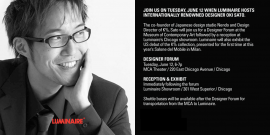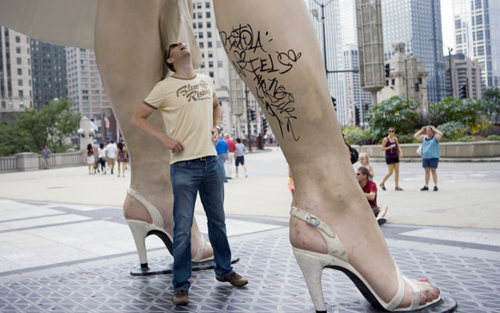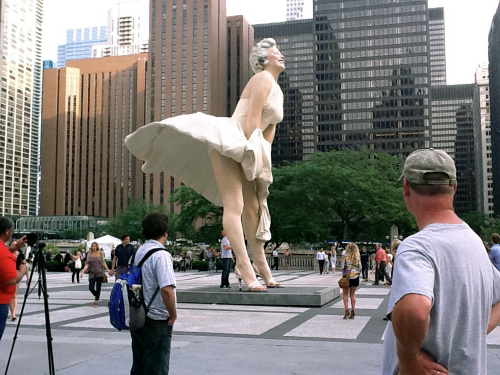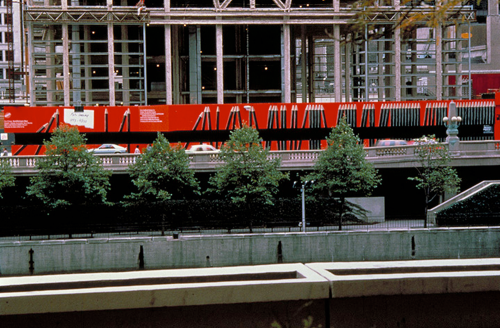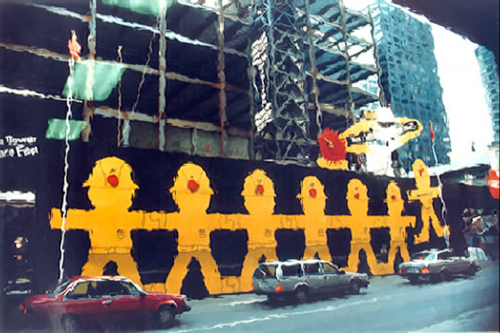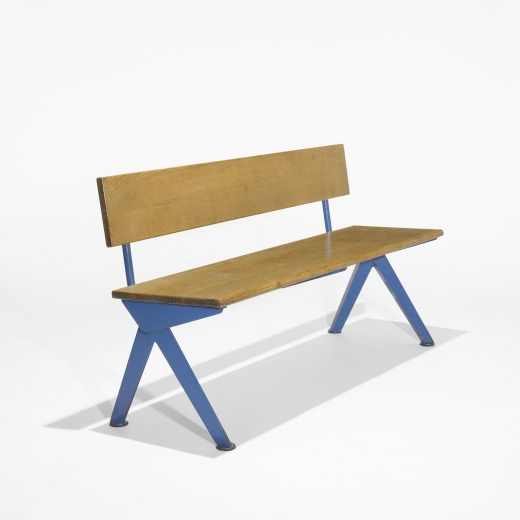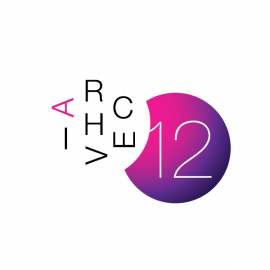
A special offer for DesignApplause followers and friends. The Archive 12 deadline to submit has been extended to 6 August 2012. Archive 12 is an annual Chicago regional design competition. [ details and entry form ]
 click > enlarge
click > enlarge
On 29 July Target is opening three stores in Chicago, Los Angeles and Seattle. Chicago’s store is in one of the city’s most architecturally significant Louis Sullivan designed building (formerly Carson Pirie Scott) which many have been waiting for with mixed emotions. Target had promised not to deface the landmark building and has kept their word. CityTarget is a “little box” concept that will feature fresh food, clothing and electronics. The State Street CityTarget occupies roughly 124,000 square feet and about 54,000 feet is selling space. This is the second CityTarget in Chicago. Another Los Angeles and San Francisco store will open in October. A third Los Angeles store and one in Portland will open in 2013.

The San Francisco store is located in the new Metreon in the Yerba Buena Center Redevelopment Project Area and will occupy 85,000 square feet.

A Seattle store located at the intersection of 2nd Avenue and Pike Street is a 3-story store occupying 103,000 square feet.

above> CityTarget mini-golf promotion aboard a Washington State Ferries vessel on the Seattle/Bainbridge route.
If you’re aware of the JC Penny rebranding and the CityTarget concept, you can visualize two retailers seeking a new and similar niche. Both are pushing design and value. JCP new ceo, Ron Johnson, a former Target and Apple store retail change agent, has partnered with several designers and the designer brands may be more visible than the Chicago CityTarget store I recently visited. CityTarget seems light years ahead of JCP at the moment, though Johnson must feel good that JCP is mentioned in this design-related post. Of interest is the latest CB2 catalog, which also featured designers and objects found at the 2012 Milan Salone. This is CB2’s best designed object catalog and puts them head-to-head with DWR more than ever before. These four retailers are specialists selling a select mix of clothes, electronics, furniture and kitchen and bath accessories. There’s also a new hip, good-value online segment from other brands that’s figured out how showcase and sell. [ citytarget ] [ cb2 ] [ dwr ] [ jcp ]
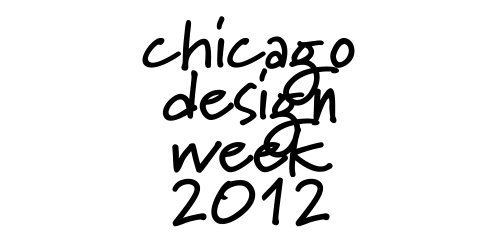 11 > 16 june 2012 | this is the third annual chicago design week. quite a bit of design going on elsewhere too. [ aiga @AIGAchicago ] [ chicago design museum @chidm ] [ idsa @IDSAchicago ] [ neocon @neocon ] [ shared practice @SharedPractice ] [ sta @STA_CHICAGO ] @DesignApplause sez can you tweet that ?
11 > 16 june 2012 | this is the third annual chicago design week. quite a bit of design going on elsewhere too. [ aiga @AIGAchicago ] [ chicago design museum @chidm ] [ idsa @IDSAchicago ] [ neocon @neocon ] [ shared practice @SharedPractice ] [ sta @STA_CHICAGO ] @DesignApplause sez can you tweet that ?

The theme for Neocon, the U.S. contract furniture industry trade show, is “Think Big.” The 2012 theme also means think global: 80 manufacturers representing 20 countries this year. The programming is also international. A pre-registration period ends 4 June. [ neocon ] [ exhibitors a > z ]
event: neocon 2012
venue: merchandise mart | chicago
dates: 11 > 13 june 2012
 click all images > enlarge
click all images > enlarge
The ( Chicago ) finances are really bad. How bad is it? Not only are our pockets hurting but our eyes are starting to hurt too. Several days ago Bank of America buys newly appointed ad space on the Chicago River bridge towers. Here’s how it went down. The timing put the ad placement two days prior to newly appointed mayor, Rahm Emanuel’s, austerity budget proposal to the City Council. The Chicago aldermen approve the mayor’s first budget 50-0, though some aldermen said they’re giving the new mayor the benefit of a doubt and seeing how things play out. I’m thinking the same thing: The mayor hates how the advertising looks, but he places the controversial ads to make a point these are desperate times. He will support revenue raising ad revenue with visuals and placement that beautify eyesores and sponsored feel-good messaging.
 the future in urban advertising may have begun in tokyo’s ginza.
the future in urban advertising may have begun in tokyo’s ginza.
While Chicago waits let’s think about what we might have to look forward to. Reasoning is heavily influenced by 12 Monkeys, Minority Report and Blade Runner.Tokyo’s (above) Ginza was an ad magnet in the 60s. Another Asian ad centric city is Hong Kong. Metro-mega-ad-landscapes appear in traditionally high traffic venues. The traffic first attracts the media and maybe at a certain threshold the media draws more crowds. Most cities are struggling to make ends meet and luckily they can control and influence the manner of advertising and their revenue opportunities while keeping aesthetics and quality of life in the mind’s eye. Some cities will do a much better job than others.
 we can expect more cities following new york’s times square model.
we can expect more cities following new york’s times square model.
I don’t mind Times Square’s visual barrage. Maybe it fits one’s expectations but I’m entertained. And this messaging is confined to Times Square. Why do so many people go there?

Back to Bank of America. The Chicago Marathon makes an enviable amount of money for both BA and the city. Any problem with appropriate messaging here on either the banner or the lamp posts?
 trump tower | chicago
trump tower | chicago
If advertising is one solution to Chicago’s finances let’s consider both public and private sector concepts. Now popular is turning existing glass surfaces and windows into digital advertising masterpieces. From the inside you don’t see the artwork. Bad idea to use architecture unless structures are scheduled for demolition, under construction, or being (below ) renovated.
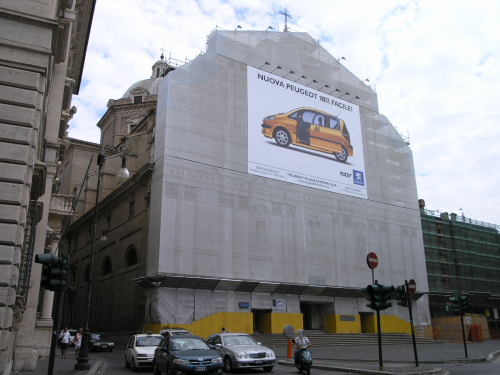 cathedral rehab | rome
cathedral rehab | rome
The fabric-covered scaffold concept may cost a bit more, but Rome is a tourist destination and she has an architectural legacy to protect. The fabric packaging is seen everywhere including public, commercial, and residential architecture. This package can be up 1-3 years.
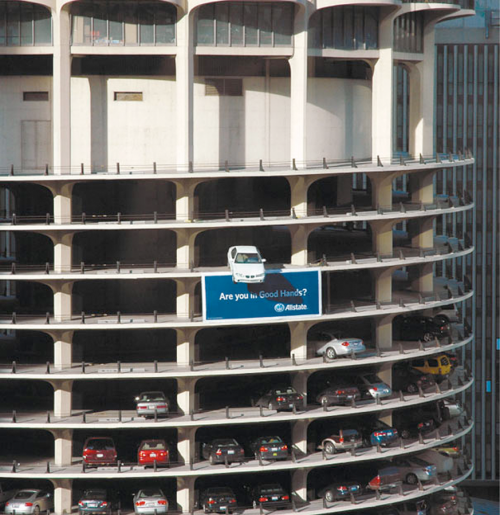 marina towers | chicago
marina towers | chicago
Marina Towers and Allstate Insurance team up. Inspired by scene from Steve McQueen’s 1968 movie Bullit. But it’s not big, not bright, a taint understated. For many reasons pretty cool.

I don’t mind sidewalk advertising and most sidewalks are public owned.. The visual clutter is minimal though placement concerns include safety and an appropriate venue. Begging for hopscotch concept.
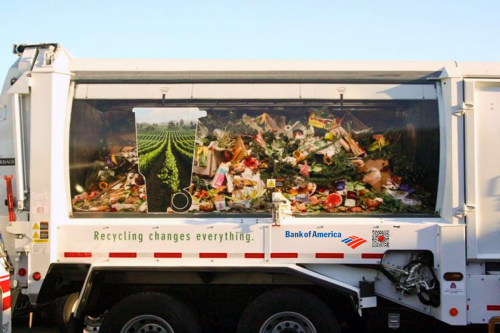
Mayor candidate Emanuel proposed ads on garbage trucks in January 2011, to raise funds for after school programs. Not long ago in Chicago we transformed cows into art which raised revenue and then publicly displayed the artsy bovines. An advertiser who aligns itself favorably with a public service and communicates with wit and artfulness works, even on a garbage truck.
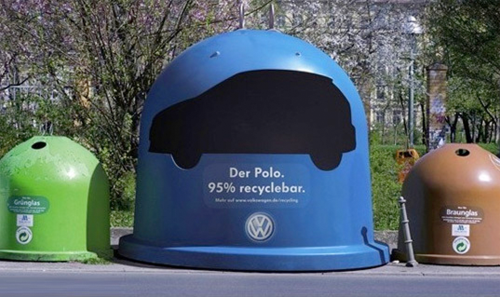 volkswagen | berlin
volkswagen | berlin
Another good idea that encourages mostly locals to wait to drop and recycle.
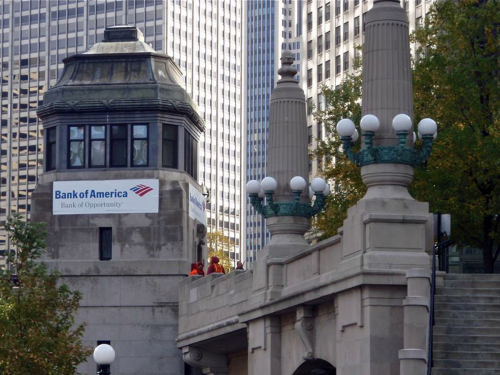 wabash street bridge over the chicago river
wabash street bridge over the chicago river
The Emanuel administration thinks such corporate advertising will raise as much as $25 million in revenue from corporate advertising on everything from buildings to the city’s website to garbage cans and parking pay boxes. He might be right on the $25M but don’t expect more of the same ads that adorn the bridges. He knows that tourism comes to Chicago to embrace the architecture. The media has said that companies have been in a wait-and-see mode and gutsy of BOA to kick the can down the road first. Realize, the advertising will indeed come. Maybe there’s a tax on bad advertising. The BOA ads adorn the Wabash Street bridge through December 12. Maybe Rahm is messing with us too to get it all right again.
[ resources ]
adland.tv
blair kamin chicago architecture critic
bored panda
buswrap.com
gothamist
overground arts
three steps over japan
 click on photos to enlarge
click on photos to enlarge
The C3 Prefab project, is a prototypical example a prefabricated sustainable residence (Chicago’s first) constructed in an urban environment.
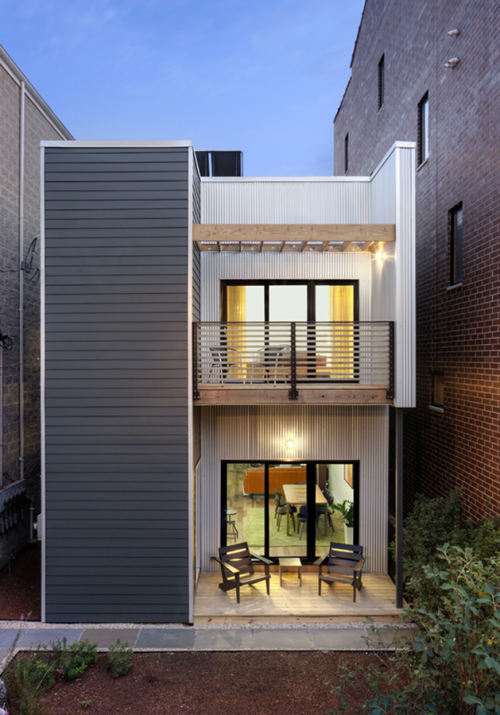

C3 sets a high standard for energy efficiency by surpassing the current energy code by 54%, and becoming the first model for sustainable, affordable housing in Chicago. Reducing the upfront cost of housing is only part of the equation. The compounded savings by reducing energy usage gives homeowners an additional $282,000 at 10% over a 30-year period.

The C3 was designed to meet the LEED Platinum and Energy Star standards with low-tech, common sense solutions in lieu of expensive gadgetry. Many materials used were sustainably harvested as well as sourced through local vendors to encourage economic growth within the region. To date, this project has received Energy Star.
Relative to this project, the word ʻprefabʼ means that portions of the home were constructed off-site and shipped to the project location once the foundation and utilities were prepared. There are many prefab benefits. There’s a higher level of quality control within a factory setting. No “bad weather” means year-round, simultaneous construction for speedier delivery and timelines are more predictable. And an economy of labor and material Reducing labor and through the use of repetitive assembly lines and volume purchasing.
[ sustainable materials | benefits ]
• Uses 54% less energy and produces 64% less emissions then a comparable home. • Energy savings of over 70% in water heating costs due to solar thermal panels and on-demand water heating.
• Recycled content, low-maintenance exterior siding (galvalume corrugated and fiber cement board), and reclaimed barnwood siding.
• Low-VOC water based sealants and finishes; cabinetry and woodwork that contain no formaldehyde or toxic binders.
• Water-conserving plumbing fixtures and energy-efficient appliances and lighting; at least 80% of lighting is either compact fluorescent or LED.
• Recycled/sustainably harvested flooring (hickory and cork).
• Efficient floor plan with high ceilings and substantial natural light and ventilation reduce lighting and heating/cooling loads.
• Ductless, high-efficiency heating & air conditioning system provides quiet operation and controlled zoning for higher level of interior comfort.
• Heat Recovery Ventilator (HRV) provides continuous outdoor air circulation without energy loss.
• Natural native landscaping provides minimal maintenance and utilizes reclaimed storm water for irrigation.
• Roof is designed for future roof deck, vegetated green space, and photovoltaic (electricity producing) solar panels.
• All wood framing is FSC certified.
[ project data ]
designer: architect square root architecture + design jeffrey sommers
location: chicago usa
project size: single-family | 2039 sqft
hers rating: 46
[ resources ]
manufacturer: Hi-Tech Housing
general contractor: Helios Design + Build
energy consultant: The Sylvan Company
green rater/energy rater: Energy Diagnostics
interior furnishings: Post 27
landscape architect: KMS Gardens and Design
solar panel design & installation: Solar Service, Inc
mechanical consultant and installation: Ardmore Fresh Air
window consultant: Murphys Windows
[ materials and products ]
hvac system: Fujitsu Ductless
windows & doors: THV Compozit
kitchen & bath cabinetry: EcoUrban Collection
lighting consultant: Lightology
low-vov paint: Color Eco Paint Boutique
corrugated galvalume siding: Firestone UnaClad
cement board lap siding: James Hardie
floor & wall tile: Dal-Tile
erv: RenewAire
tankless water heater: Noritz
information/contact: architect square root architecture + design jeffrey sommers
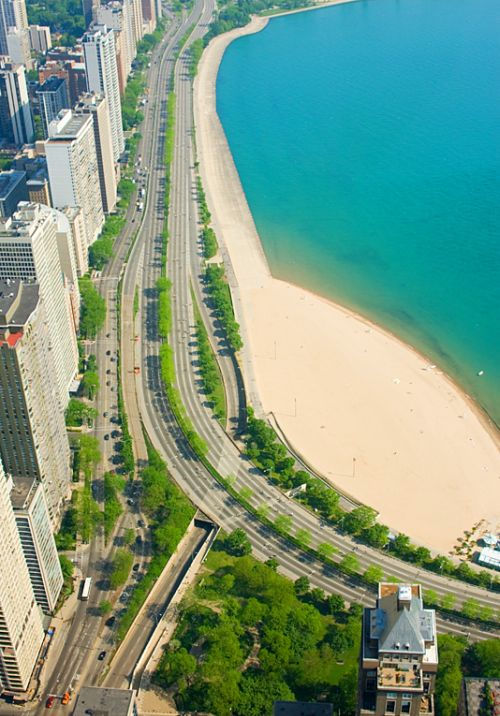 from high atop the john hancock building looking north. notice no cars only bicycles on two ( outer ) drive lanes.
from high atop the john hancock building looking north. notice no cars only bicycles on two ( outer ) drive lanes.

above: with john hancock in the foreground we are looking southwest. the green dot is the midway point between a 15-mile stretch on lsd that is closed down from 6am – 10am. the orange dot 7.5 miles away ending at the museum of science and industry.
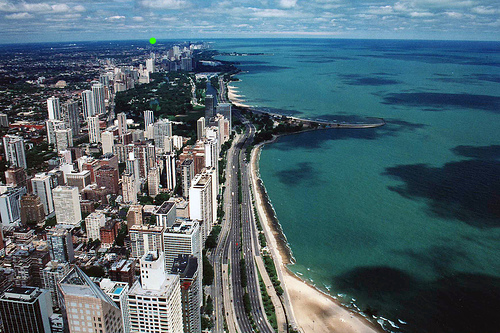
above: looking north again, the green dot 7.5 miles away where the drive abruptly ends. of interest, lsd is on a landfill, part of a plan ( daniel burnham plan ) to keep the lakefront open to the public.
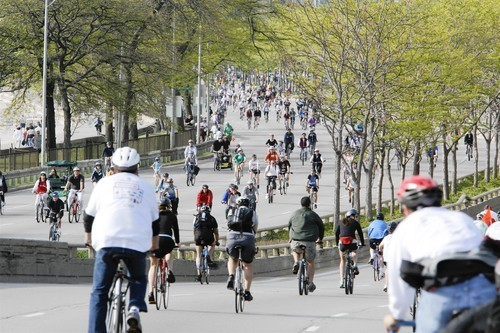
above: back down to earth this near the midway point where 18,000 will pass.

above: a 2006 cervelo soloist team with zipp 404 clinchers, zero gravity brakes, campy record, selle CF seat, and CSC water bottles. with the $2350 zipp 404 wheels this bike is $9000. not mine btw.
may 30, 2010, was the ninth annual MB financial bank “bike the drive.” the event is a fundraiser for the active transportation alliance chicago’s voice for better biking, walking and transit. the fun continues at the post-ride festival from 8 a.m. to noon in grant park, with live entertainment, event sponsor giveaways, and $7 breakfast options from goose island brew pub.
History:
early bicycles arrived in Chicago in the 1860s. by 1900, there were 54 bicycle clubs with more than 10,000 members. by the late 1890s, chicago was the “bicycle-building capital of america”. according to the 1898 chicago bicycle directory, approximately two-thirds of the country’s bicycles and accessories were manufactured within 150 miles (240 km) of the city.
chicago has recently seen an increase in the amount of bikers traveling throughout the city. this can in part be attributed to the current mayor, richard m. daley. daley has said, “my goal is to make the city of chicago the most bicycle-friendly city in the U.S.” daley created a mayor’s bicycle advisory council (MBAC) in order to encourage bicycling in the city.
the council created the chicago department of transportation bike program. the program, whose efforts are guided by the bike 2015 plan, approved in june 2006, has created over 100 miles (160 km) of new bike lanes, installed 10,000 bicycle racks, and installed 165 miles (266 km) of signed bike routes in 2006.
Resources:
bike the drive org
cycling in chicago
2015 bike plan
twitter journalism
100 years. daniel burnham










